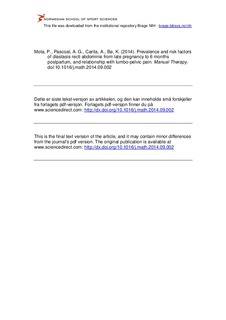| dc.contributor.author | Mota, Patricia | |
| dc.contributor.author | Pascoal, Augusto Gil | |
| dc.contributor.author | Carita, Ana | |
| dc.contributor.author | Bø, Kari | |
| dc.date.accessioned | 2014-11-24T14:25:45Z | |
| dc.date.available | 2014-11-24T14:25:45Z | |
| dc.date.issued | 2014 | |
| dc.identifier.citation | Manual Therapy. 2014. doi:10.1016/j.math.2014.09.002 | nb_NO |
| dc.identifier.uri | http://hdl.handle.net/11250/226392 | |
| dc.description | I Brage finner du siste tekst-versjon av artikkelen, og den kan inneholde ubetydelige forskjeller fra forlagets pdf-versjon. Forlagets pdf-versjon finner du på www.sciencedirect.com: http://dx.doi.org/10.1016/j.math.2014.09.002 / In Brage you'll find the final text version of the article, and it may contain insignificant differences from the journal's pdf version. The definitive version is available at www.sciencedirect.com: http://dx.doi.org/10.1016/j.math.2014.09.002 | nb_NO |
| dc.description.abstract | Diastasis recti abdominis (DRA) is an impairment characterized by a midline separation of the rectus abdominis muscles along the linea alba. It has its onset during pregnancy and the first weeks following childbirth. There is scant knowledge on both prevalence and risk factors for development of the condition.
The aim of this study was to investigate the prevalence of DRA at gestational week 35 and three timepoints postpartum, possible risk factors, and the relationship between DRA and lumbo-pelvic pain.
Ultrasound images of inter rectus distance (IRD) were recorded in 84 healthy primiparous women, at three locations on the linea alba. The IRD was measured at: gestational week 35 and 6–8, 12–14, and 24–26 weeks postpartum. Diagnosis of DRA was defined as 16 mm at 2 cm below the umbilicus. Independent sample t-test and binary logistic regression was used to assess differences and risk factors in women with and without DRA and women with and without lumbo-pelvic pain. P < 0.05 was considered statistically significant.
The prevalence of DRA decreased from 100% at gestational week 35–39% at 6 months postpartum. No statistically significant differences were found in prepregnancy body mass index (BMI), weight gain, baby's birth weight or abdominal circumference between women with and without DRA at 6 months postpartum. Women with DRA at 6 months postpartum were not more likely to report lumbo-pelvic pain than women without DRA.
DRA is prevalent at 6 months postpartum, but is not linked with lumbo-pelvic pain. | nb_NO |
| dc.language.iso | eng | nb_NO |
| dc.publisher | Elsevier | nb_NO |
| dc.subject | abdominal exercise | nb_NO |
| dc.subject | pregnancy | nb_NO |
| dc.subject | diastasis recti | nb_NO |
| dc.subject | ultrasound | nb_NO |
| dc.title | Prevalence and risk factors of diastasis recti abdominis from late pregnancy to 6 months postpartum, and relationship with lumbo-pelvic pain | nb_NO |
| dc.type | Journal article | nb_NO |
| dc.type | Peer reviewed | nb_NO |
| dc.subject.nsi | VDP::Medical disciplines: 700 | nb_NO |
| dc.source.journal | Manual Therapy | nb_NO |
| dc.description.localcode | Seksjon for idrettsmedisinske fag / Department of Sports Medicine | nb_NO |
